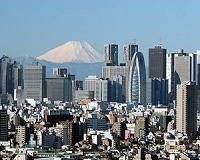 |
Osaka (AFP) March 25, 2011 Disaster-struck Japan is bracing for months of energy shortages that could curb factory production and force households and workers to sweat out the humid summer with little or no air conditioning. The world's number three economy, which endures 20 percent of all major earthquakes, generates about 30 percent of its power from nuclear plants. The record 9.0-magnitude tremor and monster wave which battered Japan's northeast coast on March 11 prompted 11 of Japan's 55 nuclear reactors to automatically shut down and triggered a major crisis at a plant in Fukushima. The nuclear problems are causing "serious constraints on the supply of electricity", so managed blackouts are likely to continue "at least over the summer," said Credit Agricole economist Susumu Kato. "This could give additional downside risks to economic activities that are already severely hit by the earthquake and tsunami," he wrote in a report. The six reactors at the Tokyo Electric Power Co. (TEPCO) Fukushima Daiichi (No. 1) plant -- three of which were operating when the quake struck -- are unlikely to ever be used again. Three reactors were already idle at the world's largest nuclear power plant at Kashiwazaki-Kariwa on Japan's western coast due to a 2007 earthquake, and the recent disaster also damaged several thermal power plants. As a result the region served by TEPCO faces a power supply shortfall of at least 10,000 megawatts, or about 20 percent of demand, chief government spokesman Yukio Edano told reporters on Friday. That means Japan may have to take its annual summer "Cool Biz" campaign -- aimed at limiting the use of air conditioning and encouraging workers to ditch their jackets and ties -- to a new level. Power outages in areas served by TEPCO since March 14 have already limited train services while major manufacturers such as Toyota and Honda have halted production and the likes of Toshiba and Sony have temporarily closed plants. The IMF warned Thursday that sustained power shortages could threaten Japan's economic recovery prospects. "The uncertainties from the nuclear situation and the power interruptions could weigh on the recovery by disrupting production across the country, and by weighing on corporate and household sentiment," said its Asia Pacific chief Ken Kang. TEPCO is one of the world's largest power companies with 44.6 million customers -- more than one third of the population of Japan -- in the Kanto region of the main island of Honshu, including Tokyo. On Friday it was able to produce 37,500 megawatts, barely enough to meet demand, and rolling blackouts are expected until the end of April. But the real crunch could come in the hot summer months of July and August when daily consumption in its region usually jumps to 55,000 megawatts. A TEPCO official said it was looking to boost its supply capacity to 46,500 megawatts. It is now racing to increase electricity supply from other plants, including a thermal power station near Tokyo that had been mothballed, but experts say it might not be enough to make up the shortfall. "The earthquake in northeastern Japan crippled about a 10th of the country's electricity generation capacity, particularly for nuclear and thermal power. Some of the damage may be beyond repair," Standard and Poor's warned. "Japan's affected nuclear power capacity is not likely to come on stream anytime soon... Existing thermal power plants in Japan may not have sufficient excess capacity, and building new thermal capacity will take time," it said. The problem is compounded by the fact that western Japan uses a different electric frequency than the east, limiting the amount of power than can be transferred between the two regions. The government said Friday that it might raise utility rates and introduce daylight saving time in a bid to save power, while local media are speculating it might restart the three idle reactors at Kashiwazaki-Kariwa.
Share This Article With Planet Earth
Related Links
 Saving Electricity In A Hurry-Tokyo Has Done It Before And Can Do It Again
Saving Electricity In A Hurry-Tokyo Has Done It Before And Can Do It AgainParis, France (SPX) Mar 24, 2011 Not long ago, Japan faced a major power crisis. In September 2002, the Tokyo Electric Power Company (TEPCO) was forced to shut down 17 nuclear power plants for emergency safety inspections. The winter of 2002-2003 was approaching, and the plants, which were expected to remain closed for months, would be unavailable through summer 2003, a time when demand from summertime air conditioning wo ... read more |
|
| The content herein, unless otherwise known to be public domain, are Copyright 1995-2010 - SpaceDaily. AFP and UPI Wire Stories are copyright Agence France-Presse and United Press International. ESA Portal Reports are copyright European Space Agency. All NASA sourced material is public domain. Additional copyrights may apply in whole or part to other bona fide parties. Advertising does not imply endorsement,agreement or approval of any opinions, statements or information provided by SpaceDaily on any Web page published or hosted by SpaceDaily. Privacy Statement |